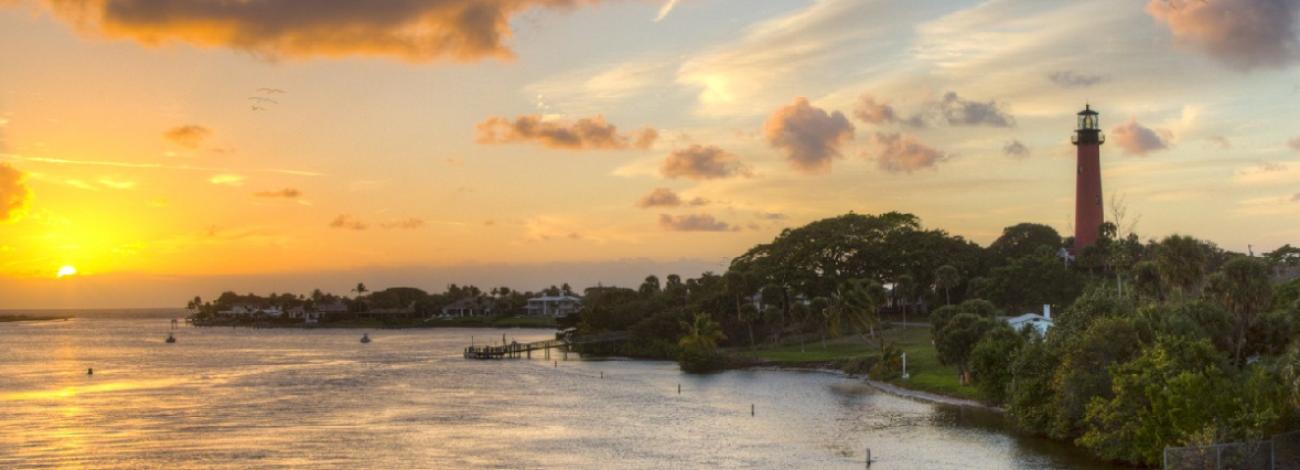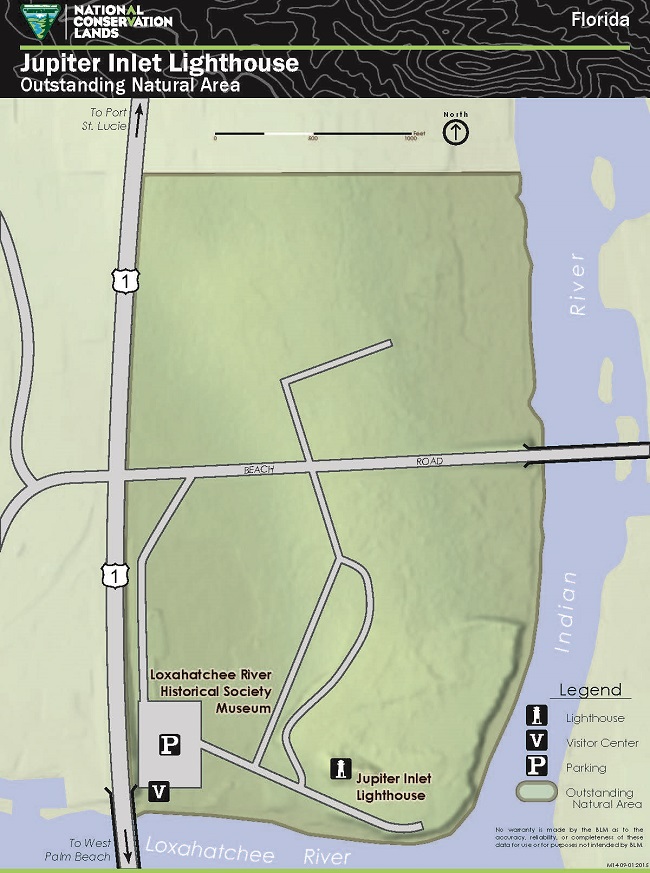
Jupiter Inlet Lighthouse Outstanding Natural Area
In northern Palm Beach County on Florida’s urbanized Treasure Coast lies the 120-acre Jupiter Inlet Lighthouse Outstanding Natural Area (ONA). The ONA was designated by Congress in 2008 for the preservation, protection and enhancement of seven key resources and values found on the site; these include the remarkable biodiversity and rich history of the site. The site is the only unit of the National Conservation Lands east of the Mississippi River, and the only unit managed by the BLM’s Eastern States.
- About
The ONA is home a remarkable array of natural and cultural resources including four sensitive habitats, 26 special status species, and an archaeological record providing evidence of human occupation dating back over 5,000 years. These historic, cultural and natural resources serve as the bases on which the Congressional designation directs the protection, preservation and enhancement of the sites key values.
Besides its namesake, the historic Jupiter Inlet Lighthouse, the ONA offers a variety of other visitor experiences. Take a gentle walk along a hardened trail and boardwalk though native and restored Florida coastal habitats, or participate in exciting interpretive programs about the site’s important role as a U.S. intelligence spy station during World War II, and its unique military history.
For more information, follow us on the ONA’s Facebook Page.
- Hours
The hours of operation for the ONA’s trails and natural areas are from dawn to dusk daily.
The lighthouse is open for guided tours only. Tours of the lighthouse and the museum are operated by the Jupiter Inlet Lighthouse and Museum, with hours that vary throughout the season.
January - April: Open 7 Days a Week ~ 10 a.m - 5 p.m.
May - December: Open Tuesday - Sunday ~ 10 a.m. - 5 p.m.An admission fee is charged by the Jupiter Inlet Lighthouse and Museum for tours of the lighthouse. Please note that tours may be delayed or cancelled due to weather restrictions including rain, lightning, thunder and high winds.
- Visit the ONA/Trails (Directions and Access)
 The Jupiter Inlet Lighthouse ONA is visited annually by thousands of people from the local community, across the U.S., and abroad. In fact, recreational values and education were key components of the legislation designating the site an Outstanding Natural Area. Although the site is small – just 120 acres - there’s plenty to see and do! For convenient access to the ONA’s trails and natural areas utilize the small parking area on the north side of S. Beach Road, 0.17 miles east of U.S.
The Jupiter Inlet Lighthouse ONA is visited annually by thousands of people from the local community, across the U.S., and abroad. In fact, recreational values and education were key components of the legislation designating the site an Outstanding Natural Area. Although the site is small – just 120 acres - there’s plenty to see and do! For convenient access to the ONA’s trails and natural areas utilize the small parking area on the north side of S. Beach Road, 0.17 miles east of U.S.From I-95, exit Indiantown Road east. Turn north (left) at US Hwy 1. Turn east (right) at Alt.A1A/S. Beach Rd. For your convenience, a geo-reference Adobe PDF map (for download) and an interactive online map are available.
North of S. Beach Road
The area north of S. Beach Road (Lot 15) is open daily from dawn till dusk for walking and wildlife viewing. This portion of the ONA contains a small parking lot, informational kiosk, hardened trail and boardwalk, and a scenic observation deck. A small area within Lot 15 (Lot 16) is closed to all public access due to ongoing U.S. Coast Guard Operations.
South of S. Beach Road
The natural areas south of S. Beach Road (Lots 17 and 19) are accessible by our new trail! Please park in the north parking lot on S. beach RD and cross the street to access the trail head. If you’re curious about these areas, guided tours provided by the Loxahatchee River Historical Society, are available the first Saturday of every month. More information can be found on the Jupiter Inlet Lighthouse and Museum website. The shoreline is particularly sensitive and dangerous at this time and the public is asked not to access this area above the median high water mark for their own safety and to prevent unnecessary erosion to the exposed faced for the dunes.
*Please note that dogs and bicycles are not allowed on the ONA's trail system.
- Visit the Lighthouse/Lighthouse Park (Directions and Access)
The ONA is accessed at two locations on the western end of S. Beach Road (C.R. 707/S.R. 707) near the intersection with U.S. 1. For the museum and tours of the lighthouse please access the ONA via the Town of Jupiter’s Lighthouse Park.
Lighthouse Park
Lighthouse Park (Lot 20) was patented to the Town of Jupiter by the Secretary of the Interior in October 2004 after six years under a Recreation and Public Purpose Act lease, and has been completely renovated with new ball fields and parking facilities and continues to host active athletic programs. Lighthouse Park also includes four tennis courts which are open to the public from dawn to dusk daily. More information can be found on the Town of Jupiter website.
Jupiter Inlet Lighthouse
The Jupiter Inlet Lighthouse itself, its ancillary facilities and associated buildings (Lot 18) are currently under the jurisdiction of the U.S. Coast Guard. The area, including the shoreline, is closed to general public access. Through a long running partnership however, guided tours are provided daily between January and April, and every day but Monday from May through December. More information on these tours can be found on the Jupiter Inlet Lighthouse and Museum website.
- Historic and Cultural Resources
The ONA was designated for the preservation, protection and enhancement of seven key resources and values. These values were grouped in the designating legislation into the following board categories: Historic, Natural, and Cultural Resources and Scientific, Educational, Recreational, and Scenic values.
Historic and Cultural Resources
The Jupiter Inlet Lighthouse sits at a prominent location bordered by the Loxahatchee and Indian Rivers. There is archaeological evidence of continuous Native American habitation from 3000 B.C. until 1763 A.D., when the first archeological evidence of an English settlement is recorded. President Franklin Pierce ordered the Ft. Jupiter Lighthouse Reservation in 1854 and Lt. George Meade, later Union General at the Battle of Gettysburg, was selected to design the structure. The Jupiter Inlet Lighthouse was completed in 1860; the resulting 108-foot brick tower was topped with a first-order Fresnel lens manufactured in Paris by Henry-LePaute. The light was first lit in 1860, although it was disabled during much of the Civil War by the assistant lighthouse keeper, a Southern sympathizer.
Through the years the site has served as one of the first U.S. Weather Bureau and Signal Stations, a U.S. Navy Wireless Station, Radio Compass Station, and a successful German U-boat tracking station during WWII. The Jupiter Inlet Lighthouse remains an active aid to navigation and is one of only thirteen of the original First Order lens still in use in the United States.
Key Past Actions:
- The Jupiter Inlet Lighthouse and surrounding archeological site were placed on the National Register of Historic Places in 1973.
- The pre-historic midden behind the Station J building was capped in 1998.
- The Jupiter Lighthouse underwent a complete restoration in 1999 – 2000 at a cost of $858,000.
- The Station J building received a $1.1 million restoration by the Town of Jupiter and is leased to the Loxahatchee River Historical Society in 2006. It now houses the museum, gift shop and offices.
- The Loxahatchee River Historical Society’s public tours and programs reached 57,394 visitors from July 2007-June 2008.
- Relocation and restoration of the Tindall house, Palm Beach County’s oldest known residence, and associated bricked walkway and native plantings will be completed in 2008.
- Natural Resources
The ONA was designated for the preservation, protection and enhancement of seven key resources and values. These values were grouped in the designating legislation into the following board categories: Historic, Natural, and Cultural Resources and Scientific, Educational, Recreational, and Scenic values.
Natural Resources
The ONA straddles an ancient coastal dune system with remnants from Indian River County south through Palm Beach County. High and dry these ancient dunes were among the first areas to be developed along the Treasure Coast and scrub habitats are now isolated in small patches in Palm Beach County.
Currently 63 acres in Lots 15 and 19 are predominately scrub habitats. Three prescribed burns have been conducted in three blocks over the last ten years. Most of the aged sand pine remaining in the unburned blocks was killed by the 2004 hurricanes, transforming much of the tract. On the eastern portion of the tract there is a narrow band of tropical hardwood hammock transitioning into mangrove and a tidal lagoon along the Indian River Lagoon/Intracoastal Waterway.
Special Status Species
- Four-petal pawpaw (Asimina tetramera), Federal and State-listed as Endangered
- Perforate lichen (Cladonia perforata), Federal and State-listed as Endangered
- Florida Scrub Jay (Aphelocoma coerulescens) Federal and State-listed as Threatened (not seen onsite since 2003)
- West Indian manatee (Trichechus manatus), Federal and State-listed as Endangered
- Gopher tortoise (Gopherus polyphemus), Florida Species of Special Concern
- Brown pelican (Pelecanus occidentalis), Florida Species of Special Concern
- Little Blue Heron (Egretta caerulea), Florida Species of Special Concern
- Tri-colored heron (Egretta tricolor), Florida Species of Special Concern
- Curtiss milkweed (Asclepias curtissii), State-listed as Endangered
- Large-leaved rosemary (Conradina grandiflora), State-listed as Threatened
- Nodding pinweed (Lechea cernua), State-listed as Threatened
- Banded wild pine (Tillandsia flexuosa), State-listed as Threatened
- Reflexed wild pine (Tillandsia balbisiana), State-listed as Threatened
- Giant wild pine (Tillandsia utriculata), State-listed as Endangered
- Common wild pine (Tillandsia fasciculata), State-listed as Endangered
- Invasive Species
Thirty-eight exotic plant species have been identified on Lots 15 and 19. Thirteen of these have been identified by Florida Exotic Pest Plant Council as having the capacity to invade and disrupt native plant communities. Brazilian pepper and Australian pine dominated much of the perimeter of the tract when habitat improvement work began in 1997.
Key Past Actions
- Three prescribed burns totaling 17 acres have been completed in Lot 15:
- 1998 - 5.3 acres, scrub oaks chopped prior to burn
- 2002 - 5.8 acres, sand pine canopy removed prior to burn
- 2008 – 6 acres, post hurricane, most heavy fuels removed prior to burn
- A two-acre tidal lagoon with mangroves and upland plantings was completed in 1999.
- Removal of woody invasive plants, primarily Australian pine and Brazilian pepper, was completed by 2004. Lot 17 and portions of Lot 18 around the Jupiter Inlet Lighthouse remain untreated.
- Annual sweeps continue to control invasive vines and herbaceous exotics by hand pulling and hand applied spot treatments of herbicide in Lots 15, 16 and 19. Quarterly sweeps are conducted in Lot 18.
- Slope stabilization was completed along a section of the Loxahatchee River in 2005.
- Three prescribed burns totaling 17 acres have been completed in Lot 15:
